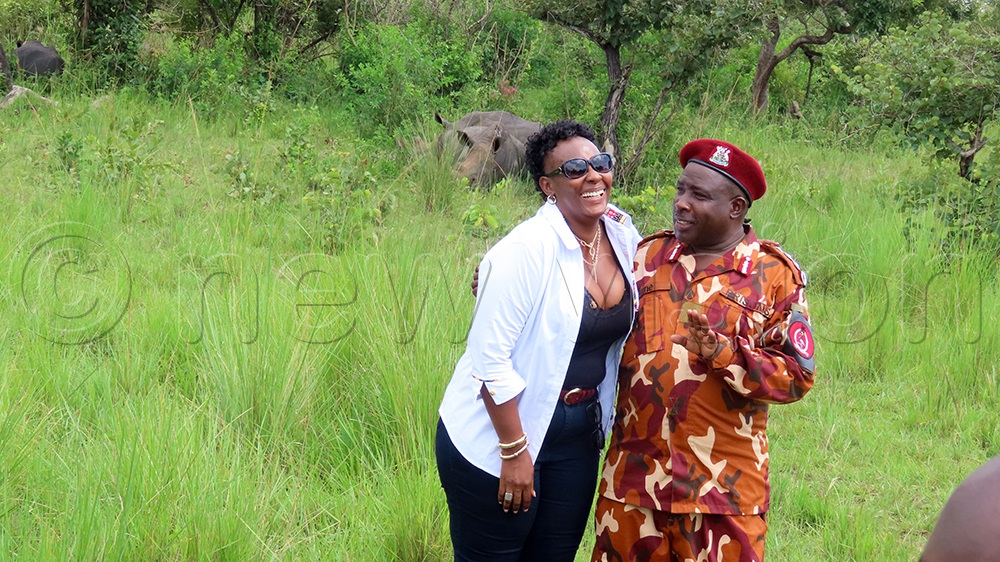How Uganda is succeeding in rhino conservation
Today, Ziwa’s rhinos roam in relative safety, guarded day and night. Tourists marvel at their prehistoric bulk and quiet majesty. School children squeal with excitement when they first spot one. However, behind the spectacle lies an expensive and relentless effort.
Right foot forward for rhinos at Uganda Wildlife Education Centre (UWEC). (Credit: Titus Kakembo)
In the sun-baked plains of Nakasongola district, a three-hour drive from Kampala city, lies Ziwa Rhino Sanctuary - home to Uganda’s only population of white rhinoceroses.
Established in 2005, the sanctuary was created to reintroduce rhinos into the country after they had been wiped out by poaching and political instability between the 1970s and 80s.
Today, Ziwa’s rhinos roam in relative safety, guarded day and night. Tourists marvel at their prehistoric bulk and quiet majesty. School children squeal with excitement when they first spot one. However, behind the spectacle lies an expensive and relentless effort.
Their conservation does not come cheap. According to Uganda Wildlife Authority’s Executive Director, James Musinguzi, the bill to keep one rhino alive and thriving is staggering.
“You are looking at not less than sh80 million per year per rhino. That covers ranger patrols, veterinary care, fuel for vehicles, and infrastructure like electric fencing. Multiply that by 40 rhinos, and you understand why financial support is critical,” Musinguzi says.
Unlike antelopes or buffalo, rhinos need 24-hour surveillance. Their horns make them lucrative targets for poachers, fetching up to $60,000 per kilogram on the Asian black market.
“It’s like guarding a bank vault in the middle of a forest. The temptation for criminals is high, so the cost of protection is equally high. Their veterinary costs are another burden. A single tranquilliser dart for medical procedures can cost more than $500. Transporting a rhino in case of an emergency requires cranes, trucks, and a specialised team - running into millions of shillings. And because Ziwa lies in a semi-arid region, water supply requires boreholes, solar pumps, and regular maintenance,” asserts Musinguzi.
To bridge the funding gap, Ziwa Sanctuary has leaned heavily on tourism. Rhino tracking remains its star attraction. International visitors pay about $45 (about shillings 157,000), while East Africans contribute shillings 40,000. Bird watching, nature walks, and accommodation on-site add to revenue streams.
On a good month, the sanctuary may welcome 3,000 visitors. But tourism is unpredictable. The COVID-19 pandemic reduced visitor numbers to near zero, throwing Ziwa into a financial crisis. Even in good seasons, revenues rarely meet half of the sanctuary’s annual budget.
Uganda Wildlife Education Centre (UWEC) Chief Warden David Musingo notes: “Uganda cannot gamble with rhino security. Whether visitors come or not, rangers must patrol daily. Vehicles need fuel, and the animals must eat. Tourism helps, but it is not enough,” shared Musingo.
“During the COVID-19 lockdown, the private sector came in handy to lend a hand as management got overwhelmed by swelling sustenance bills.”
The two rhinos kept at UWEC in Entebbe are fed nutrient-rich pellets that supplement their grass diet.
“These pellets provide the vitamins and minerals a rhino needs without consuming tonnes of grass. But they cost money - and lots of it,” Musingo says.
Myths that kill
Part of UWEC, the sanctuary’s work involves battling dangerous myths. Poachers kill rhinos for their horns, which are ground into powder and sold as aphrodisiacs or as status symbols in Asia.
“Rhino horn is simply keratin - the same substance in your fingernails. It has no medicinal value. Yet because of cultural beliefs abroad, people are willing to pay fortunes. That is why rhinos remain on the brink,” Musingo stresses.
Traditional leaders echo this call for awareness. Engineer Moses Okune, a Langi cultural head, urges Ugandan men to shun shortcuts.
“Our ancestors relied on mulondo roots, katunkuma, sesame paste, and yams. They exercised through wrestling and danced during festivals. That is how they sired strong generations. We must return to these traditions instead of fuelling myths that destroy wildlife.”
Community voices: why it matters
The sanctuary is not just about rhinos - it is about livelihoods. Communities around Ziwa benefit from employment as rangers, guides, lodge workers, and craftspeople. Local farmers supply food to lodges, while boda-boda riders ferry visitors from the highway.
“Before the sanctuary, this area was dry and poor. Now I sell cold drinks and snacks to tourists. My children’s school fees come from this business. If the rhinos go, so does my livelihood,” says Grace Namusoke, a shopkeeper in Nakasongola.
For John Bosco Okello, a ranger, the job is more than income - it is pride.
“Every morning, I track rhinos on foot. When I see them alive and healthy, I know I am guarding Uganda’s future. These animals are part of our national identity.”
The sanctuary has relied heavily on foreign grants and international NGOs. But leaders warn that Ugandans themselves must step up. Juliana Kagwa, Chief Executive Officer of Uganda Tourism Board, insists conservation is a shared responsibility.

The Uganda Prisons spokesperson, Frank Baine in a happy mood during the naming of rhinos at Ziwa Rhino Sanctuary. (All Photos by Titus Kakembo)
“This is not the work of government alone. Every Ugandan should see themselves as a stakeholder. By visiting Ziwa, donating, or simply sharing awareness, you are contributing to the survival of a species that was once lost to us.”
She adds that conserving rhinos is not just ecological - it is economic.
“Wildlife is a major pillar of Uganda’s tourism industry, which contributes over 7% of GDP. Without rhinos, we lose part of our appeal and revenue.”
Long-term sustainability plans
Looking ahead, Ziwa Rhino Sanctuary is exploring strategies to secure financial sustainability. Plans include:
• Expanding eco-tourism: More accommodation, night safaris, and cultural experiences to diversify income.
• Corporate partnerships: Engaging Ugandan businesses to adopt rhinos or sponsor ranger units.
• Community conservation projects: Sharing revenue with surrounding villages to ensure locals view rhinos as assets, not threats.
• Education programs: Scaling up school visits and nationwide campaigns to instil conservation values in the next generation.
• Research and breeding programs: Partnering with universities and wildlife scientists to position Ziwa as a regional hub for rhino conservation.
Already, discussions are underway to release some rhinos back into Uganda’s national parks once numbers are stable enough - a move that would re-establish rhinos in their historical ranges and further cement Uganda’s reputation as a wildlife destination.
The bigger picture of saving rhinos is about more than one species. As Musinguzi sums up: “Rhinos are keystone species. Their grazing patterns shape the savannah, benefiting countless other animals. Lose them, and ecosystems are thrown off balance.”
It is also about national pride. Uganda once boasted thriving rhino populations, only to see them vanish within a generation. The sanctuary’s success is a chance at redemption - a way to show the world, and the nation, that we can correct past mistakes.
The cost of extinction
So, why all the money? Because extinction is forever. No amount of wealth or regret will bring back a lost species. The cost of conservation is high, but the cost of losing rhinos is incalculable.
Ziwa Rhino Sanctuary stands as a beacon of hope, but its survival depends on more than rangers and fences - it depends on all of us. Whether through a ticket, a donation, or spreading awareness, every citizen has a role. The rhinos’ survival is tied to our own story as a nation.
If we act now, generations to come will still marvel at the sight of a rhino grazing under the Nakasongola sun. If we don’t, our grandchildren will know them only from history books.